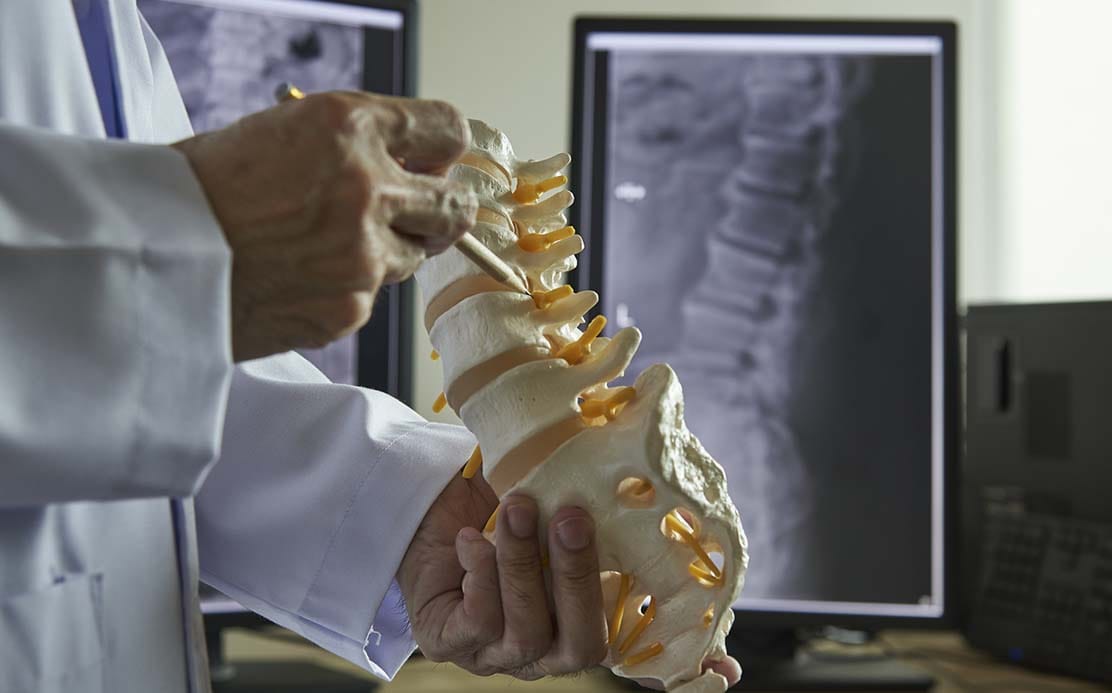Patient-Focused
Spine Care
Below are listed the procedures we perform.
Total Disc Replacement - Cervical
Cervical disc replacement is also known as total disc arthroplasty or artificial disc replacement. In this procedure, a damaged cervical disc is removed and replaced with a metal or polymer prosthetic.
First, surgeons make an incision in the side of the neck and carefully move away any tissue. The damaged disc is removed, along with any bone spurs. Then, the prosthetic is inserted and the incision closed.
Total Disc Replacement - Lumbar
Minimally Invasive Spine Surgeries
ALIF
An Anterior Lumbar Interbody Fusion (ALIF) procedure is a lumbar spine surgical procedure that is performed from the front of the body through the lower part of the stomach. During an ALIF procedure, the surgeon will remove the degenerative or diseased disc(s) and replace it with an interbody device, like Centinel Spine’s STALIF M, to assist in stabilizing the spine, restoring disc height, and assisting with fusion or healing of the neighboring vertebral bodies so they grow together.
TLIF/PLIF
TLIF is a contemporary approach to spinal fusion surgery. It is an operation performed on the lower back to remove an intervertebral disc and join two or more spinal bones (vertebrae) together using screws and a cage.
DLIF
Direct lateral interbody fusion (DLIF) is a minimally-invasive surgery that involves the removal of damaged intervertebral discs and bone, and fusing of two adjacent spinal vertebrae. It adopts a lateral approach when compared to traditional methods of spinal fusion techniques, and in doing so, spares the disruption of major back muscles, ligaments and bones, and preserves back strength.
ACDF
Anterior Cervical Discectomy and Fusion has been the gold standard in cervical spine surgery for many years. It is safe, effective, simple to perform, and easy to recover from.
An ACDF surgery has two parts. First, the damaged or herniated cervical disc is removed entirely (discectomy). Then a bone graft is placed over the affected vertebra to encourage it to grow into the backbone above or below it (fusion). This eliminates potentially painful movements of the vertebrae.
SI Joint Fusion
The Sacroiliac joint (SI joint) is located in the pelvis; it links the iliac bones (pelvis) to the sacrum (lowest part of the spine above the tailbone). It is an essential component for shock absorption to prevent impact forces from reaching the spine. Many problems can cause sacroiliac joint pain, and, fortunately, various types of SI joint treatment are available.
Spinal Treatments
With any given spinal disorder, surgical treatments can vary based on diagnosis, patient demographics, and individual circumstances because not all patients require the same solutions and surgical approach. Spinal treatments range from stimulation therapies to minimally invasive surgeries and we always take a patient-first approach that will enhance recovery and surpass expectations.

Kyphoplasty
Kyphoplasty is considered a minimally invasive surgery because it is performed through a small skin puncture rather than a larger (open) incision. A typical kyphoplasty procedure, described below, takes 1 to 2 hours per vertebral level to complete.
Microdiscectomy
Microdiscectomy, also known as microdecompression, is one of the most common minimally invasive spine surgery procedures. The main goal of microdiscectomy is to take pressure off your nerves to relieve your back pain.
Laminectomy / Foraminotomy
Laminectomy is the surgical removal of a bony area of the spine called the lamina. The lamina is the back part of each vertebra of your spine and forms the back wall of your spinal canal. Your spinal cord runs through your spinal canal in the center of your vertebrae. Certain conditions of the spine can compress the spinal cord and cause pain. A laminectomy can relieve pressure in your spinal canal and on spinal nerves by opening up your spinal canal. This surgery is also known as decompressive laminectomy.
Complex Adult Deformity/Scoliosis (Complex Spine)
Complexity in spine surgery is a relative term, but it generally refers to surgical cases that involve one or more of the following:
1. Revision of prior back or neck spine surgery
2. Scoliosis
3. Surgery across more than three spinal segments (or levels)



